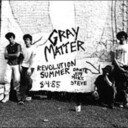
Хотите запечатлеть незабываемые моменты? Доверьте свои фотографии профессионалу! Услуги талантливого фотографа - гарантия качественных снимков и восхитительных портретов.
Тексты песен gray matter

gray matter -
burn no bridges | текст песни и табы (аккорды) для бас гитары и Mp3
2 дня назад 183,00 (не задано)
2 дня назад 183,00 (не задано)
Информация о артисте
Gray Matter легендарная старая группа,название которой переводится как "Серое Вещество".Эта группа является примером старого, грязного, кислотного панка. Именно с Gray Matter нынче так популярное течение Emo слизало стиль в одежде и музыки.Конечно пострадали и другие великолепные группы.Группа родом из 80-х 90х годов.
В середине 80-х вашингтонская сцена была самой креативной, экспериментальной и интересной. Среди множества замечательных групп Gray Matter как-то затерялись. Может, в них не было гармонии Dag Nasty, новаторства Rites Of Spring и Embrace, но мелодичная и ритмичная музыка этого коллектива звучала очень свежо по тем временам. И главное - в них был все тот же задор, так заметный во всех командах «революционного лета» и создававший совершенно определенное, специальное настроение. Пожалуй, по началу из столичных групп тех лет они были ближе всех к традиционному панку, может, именно поэтому их не превозносили, как других. Но именно это делало их оригинальными и самобытными на диси-сцене. Вторая запись ушла несколько в сторону от панка, оказалась более удалой, безумной, рокенрольной, в чем-то истеричной и была очень офигительной. Группа явно росла и развивалась, но в 1986 году скоропостижно скончалась. Реорганизовавшись через несколько лет, ребята записали неплохой, в общем-то, альбом. Но это было уже не совсем то. Read more on Last.fm. User-contributed text is available under the Creative Commons By-SA License; additional terms may apply.
В середине 80-х вашингтонская сцена была самой креативной, экспериментальной и интересной. Среди множества замечательных групп Gray Matter как-то затерялись. Может, в них не было гармонии Dag Nasty, новаторства Rites Of Spring и Embrace, но мелодичная и ритмичная музыка этого коллектива звучала очень свежо по тем временам. И главное - в них был все тот же задор, так заметный во всех командах «революционного лета» и создававший совершенно определенное, специальное настроение. Пожалуй, по началу из столичных групп тех лет они были ближе всех к традиционному панку, может, именно поэтому их не превозносили, как других. Но именно это делало их оригинальными и самобытными на диси-сцене. Вторая запись ушла несколько в сторону от панка, оказалась более удалой, безумной, рокенрольной, в чем-то истеричной и была очень офигительной. Группа явно росла и развивалась, но в 1986 году скоропостижно скончалась. Реорганизовавшись через несколько лет, ребята записали неплохой, в общем-то, альбом. Но это было уже не совсем то. Read more on Last.fm. User-contributed text is available under the Creative Commons By-SA License; additional terms may apply.
Post-hardcore band Gray Matter formed in the summer 1983 from the ashes of several Washington, D.C., area punk bands, Gray Matter's mix of melody and punk power helped key the 1984-1985 punk resurgence in the nation's capital. Consisting of guitarist Mark Haggerty and drummer Dante Ferrando (both of controversial first wave Dischord band Iron Cross), guitarist and singer Jeff Turner (founder of WGNS cassette label and studio), and bassist Steve Niles, Gray Matter was inspired by British punk bands. The band rehearsed but rarely played out, and it wasn't until the summer of 1984 that they played their first important public gigs, finding alliance with bands like Rites of Spring and Beefeater. The group made their first recordings in November of 1984, going into Dischord's "house" studio, Inner Ear, with Minor Threat's Ian Mackaye assisting with production. The recordings, which revealed the influence of early-D.C. punk ("Gray Matter," "Caffeine Blues"), also warned about the dangers of punk nostalgia ("Retrospect") and featured a surprising cover of the Beatles' "I Am the Walrus" was the first hint of the band's strong pop streak. The record was issued by a small local label, then reissued by Dischord in 1990. The group hit their stride on the August 1985 recordings that became the Take It Back EP. Crashing power chords mixed with pop melodies and rushing rhythms on "Chutes and Ladders" and the title cut, and the record stands as a landmark of the mid-'80s Dischord style. The record was cut during what came to be known as "Revolution Summer" in D.C., a period of punk solidarity that helped turn attentions away from personal concerns to political and social ones, paving the way for latter day heroes like Fugazi. Jon Kirschten replaced Haggerty in the fall of 1985, but the band had nearly run its' course, breaking up in the spring of the following year. Turner and Niles reunited with Haggerty in Three, which included former Minor Threat drummer (and Dischord co-founder) Jeff Nelson while Ferrando went on to play with Ignition. Turner also played with Senator Flux. The band reunited in late 1990, touring and recording Thog, a fine disc that showed the group's grasp of pop punk sensibilities but lacked their former power. They called it quits for good in 1993. Read more on Last.fm. User-contributed text is available under the Creative Commons By-SA License; additional terms may apply.
